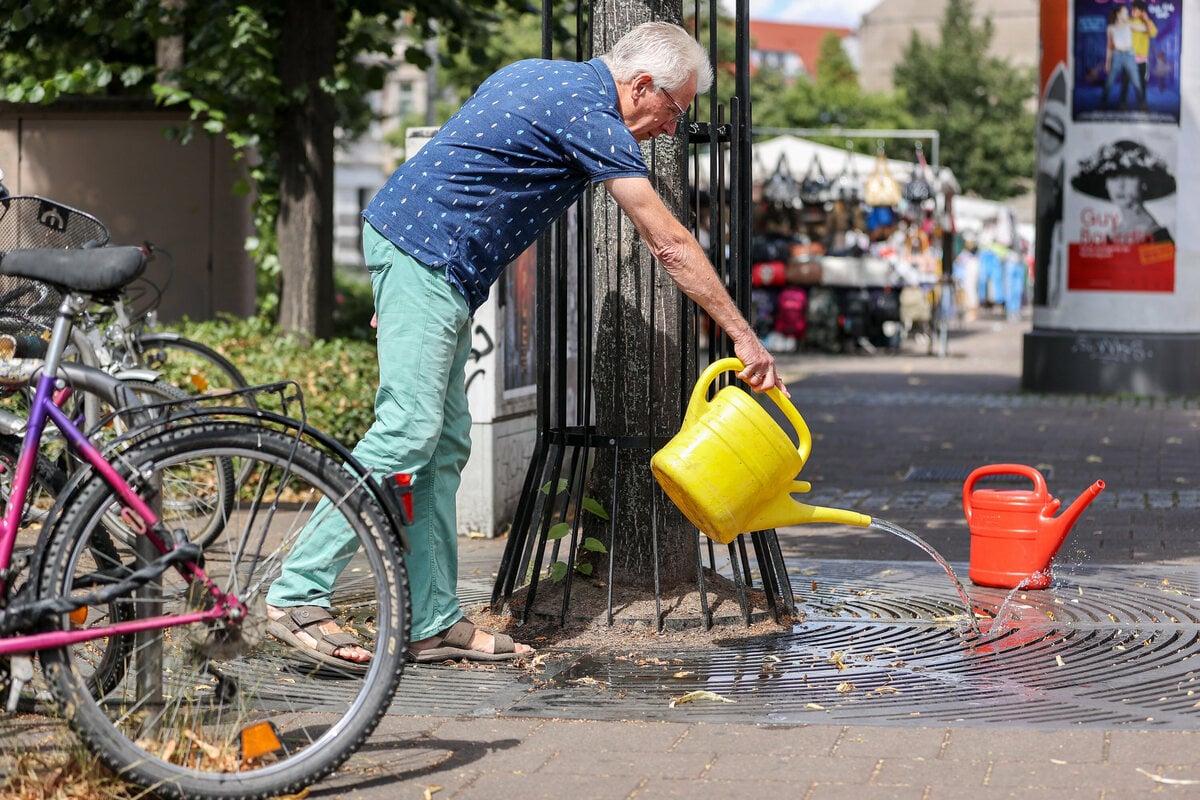Leipzig / Berlin. Uwe Buckendahl fills his two red and yellow watering cans three times a week and sets off on the few hundred meters long walk to “his” linden tree. The imposing tree is in Leipzig – and has been getting water from it regularly for some time. In 2019, the former headmaster and geography teacher heard about the initiative “Gieß den Kiez” from the Leipzig foundation “Wecken corners”. Since then, the 69-year-old has been hauling water regularly. “You shouldn’t always complain and demand, you should also take responsibility yourself. I want my neighborhood to be nice.” He carefully circles the tree with the jet of water from the watering can.
–
–
Buckendahl is not alone with his hobby. In many places, municipalities, private initiatives and environmentalists are now calling on people to water the trees on the doorstep. According to the Naturschutzbund BUND, there are “casting groups” in several cities – for example in Berlin, Cologne or Frankfurt am Main. From the point of view of experts, help is urgently needed. “The drought has a devastating effect on urban vegetation,” says Christian Hönig, tree protection specialist at BUND Berlin.
He recommends eight to ten buckets of water per tree once a week. “Water carefully with the first bucket until the pores in the soil open and absorb the water and then pour until the planting pit is saturated.” Young trees could also be watered more often.
The first signs that trees are suffering from drought: They roll up their leaves or shed them, branches become bare, the crowns light. Street trees in particular have little space for their roots, and water can only be stored “to a very limited extent”, according to Hönig. In addition, groundwater levels in the cities are usually lowered and kept low, so that the trees have difficulty getting water. In Berlin alone, according to Hönig, the number of street trees felled annually has increased to around 6,000 in the past three “dry years” – around 20 percent more than in previous years.

Uwe Buckendahl next to “his” Leipzig linden tree. © dpa-Zentralbild
Ute Bedbur from Berlin knows the problem. A tree recently had to be felled in front of her balcony at the exit of the underground car park. This is how she became aware of the subject of city trees – and decided to become active together with her house community. “A street is at least twice as beautiful when there are trees,” says the 67-year-old. Watering plans have been hanging in the entrances since May and are supposed to help water the 13 trees in the street in front of the residential complex.
Joachim Bauer thinks watering only makes sense for young trees. With old specimens you often don’t even know where roots run along – and the water doesn’t reach them. Bauer heads the working group on urban trees at the German Garden Authority Conference (Galk), in which the municipalities regularly exchange ideas on the topic. “Drought is a big issue everywhere,” says Bauer, who actually works in the Cologne Green Spaces Office. The city, in which there are around 80,000 street trees, is currently sponsoring 1,400 trees – 200 new ones have been added this year alone. Those who take on a sponsorship receive, for example, a water bag that gradually releases the precious liquid on the tree.
Although it has rained repeatedly in the past few weeks, overall it remains too dry in Germany: In June, an average of around 90 liters of precipitation per square meter fell. The value was thus in the long-term average – regionally, however, it was still very dry, they said. According to the DWD, less than 15 liters per square meter fell in parts of Brandenburg and Saxony.
“You have to think about other trees in the cities,” says Bauer. Nationwide, the municipalities are currently testing almost 40 tree species that can cope well with dry and difficult locations. Palm trees, for example, are conceivable for the summer, but they cannot cope with the frost in winter. He considers species such as the native, but so far hardly widespread field maple, but also exotic species such as the Japanese pagoda tree to be very promising.
Whereas in the past a freshly planted city tree was watered for three years by the Green Space Office, many municipalities have now passed over to seven years, reports Bauer. After that, however, the tree must see that it can take care of itself. “We can’t always keep him on an IV.” In addition, it is drinking water – and a valuable commodity. (dpa)
–


